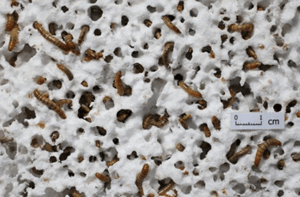Inspiring agriculture and food innovators
By Denise Faguy, Farms.com
Mike Lee chose 2065 for his future grocery store for a number of reasons. Mainly, it is because it is far enough in the future for people to leave the constraints of today out of their imagined future. Lee said that he feels this conceptualization helps to convert today’s small ideas and innovations into big ideas for the future. According to Lee, the Grocery Store of 2065 has six aisles.
1. Distributed Production
Distributed production includes concepts such as AeroFarms which means year-round, high-quality production with better yields; faster 16-day crop cycles for 22 crops a year (down from 35-70 in a field); a “growing cloth” medium; no pesticide usage; 95% less water usage; and finally, a closed-loop system able to recycle nutrients.
It also includes concepts such as a CityFarm -- No harmful run-off, and so protecting the environment. Scalable, high-performance, urban agriculture systems that fundamentally rethink “grow it THERE and eat it HERE” to “grow it HERE and eat it HERE”. This concept also includes things such as hydroponic, aquaponic and aeroponic production systems; novel environmental, diagnostic and networked sensing; control automation, autonomous delivery and harvest systems; data driven optimization; and reductive energy design.
2. Hyper Customization
Matching specific consumer desires with production is hyper customization. Food is the most personal of goods, we’ve never seen so much variety in our food choices as today, but Lee wonders how to more closely match not just what we want, but what we need.
3. Alternative Proteins
Many alternative proteins may help to meet the world population’s growing demand for protein. But Lee questioned how to meet the world’s protein demand in a way that’s better for the environment, our health, and business. He reviewed alternatives such as modern meadow and cultured meat.
4. Packaging Waste

The US generates more than 33 million tons of packaging waste, several alternative forms of packaging are under development, including shrimp shell pack – it decomposes in a couple of weeks. He also reviewed other potential packaging solutions, in addition to simply reducing packaging he included other forms of elimination such as styrofoam-eating mealworms.

5. Feeding 10 billion
Would eliminating or repurposing food waste help to solve the dilemma of feeding the world? Vegetables that don’t look pretty are often sent to waste in western countries because consumers won’t purchase an ugly carrot or blemished apply. Eliminating this waste would go a long way to feed the 10 billion. Peel and other discarded fresh produce items could also be repurposed into food of other products.
6. Mass sustainability
Companies such as Hampton Creek make egg substitutes from vegetables. They hired data scientists to scour the 400,000 kinds of plants and found, for example, that the Canadian yellow pea can be a protein substitute. Hampton Creek egg substitute is 48% more cost effective than conventional chicken eggs. What if processed food was manufactured only when the crop is “in season”, for example, lentil chips would only be available to consumers after lentil harvest?
While TheFutureMarket.com may seem too futuristic, Lee pointed out that the imagined communicator on the original star trek TV series is what inspired Martin Cooper to create the cell phone. “Better innovation in food today starts with more ambitious thinking about tomorrow,” Lee says.